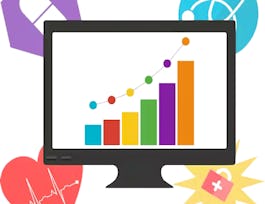Health data are notable for how many types there are, how complex they are, and how serious it is to get them straight. These data are used for treatment of the patient from whom they derive, but also for other uses. Examples of such secondary use of health data include population health (e.g., who requires more attention), research (e.g., which drug is more effective in practice), quality (e.g., is the institution meeting benchmarks), and translational research (e.g., are new technologies being applied appropriately). By the end of this course, students will recognize the different types of health and healthcare data, will articulate a coherent and complete question, will interpret queries designed for secondary use of EHR data, and will interpret the results of those queries.

Offrez à votre carrière le cadeau de Coursera Plus avec $160 de réduction, facturé annuellement. Économisez aujourd’hui.


The Data Science of Health Informatics
Ce cours fait partie de Spécialisation Health Informatics


Instructeurs : Hadi H. K. Kharrazi, MD, Ph.D
19 726 déjà inscrits
Inclus avec 
(204 avis)
Expérience recommandée
Ce que vous apprendrez
Articulate different forms of clinical and population level data.
Describe the data required to answer a healthcare information problem.
Distinguish between data questions and data queries when dealing with a healthcare information problem.
Compétences que vous acquerrez
- Catégorie : Health Informatics
- Catégorie : Data Science
- Catégorie : Data Analysis
- Catégorie : Database (DBMS)
- Catégorie : data querying
Détails à connaître

Ajouter à votre profil LinkedIn
4 devoirs
Découvrez comment les employés des entreprises prestigieuses maîtrisent des compétences recherchées

Élaborez votre expertise du sujet
- Apprenez de nouveaux concepts auprès d'experts du secteur
- Acquérez une compréhension de base d'un sujet ou d'un outil
- Développez des compétences professionnelles avec des projets pratiques
- Obtenez un certificat professionnel partageable


Obtenez un certificat professionnel
Ajoutez cette qualification à votre profil LinkedIn ou à votre CV
Partagez-le sur les réseaux sociaux et dans votre évaluation de performance

Il y a 4 modules dans ce cours
In this module, we will begin by introducing and defining databases, and placing the role of databases within the context of clinical informatics. We will continue by introducing the common health data types such as demographics, diagnosis, medications, procedures, and utilization data. We will finish this module by reviewing the emerging health data such as lab orders/results, vital signs, social data, and patient-generated data.
Inclus
6 vidéos1 devoir
In this module, we review the data specifications extracted from insurance claims and electronic health records. We will then discuss the common challenges in using health data, specifically issues with data quality, data interoperability, and data system architectures. Finally, we will describe the “Big Data” challenges of health data and explain some of the data problems that may hinder analytical efforts.
Inclus
5 vidéos1 devoir
With this understanding of the data available, it’s time to see how to turn questions you and your colleagues will have into queries the database can understand. Besides getting rules of thumb for doing this translation, you will also be introduced to three online tools available to test some of these skills. You will also watch an interview with Sam Meiselman, course instructor and the data manager in charge of the Johns Hopkins Enterprise Data Warehouse, who has to use these skills on a daily basis.
Inclus
6 vidéos1 devoir
To send home the recurring message on the challenges and art of translating questions into queries, you will see interviews with two professionals: One who comes from the data management side of the equation, and one who comes from the domain. They will give you perspectives that are both similar (the need to understand the problem for which the data are being retrieved) and different (the multiplicity of data available vs the richness of the domain problem).
Inclus
8 vidéos1 devoir1 évaluation par les pairs
Instructeurs

Offert par
Recommandé si vous êtes intéressé(e) par Health Informatics

The University of Sydney

University of Illinois Urbana-Champaign

University of Colorado System

University of California, Davis
Pour quelles raisons les étudiants sur Coursera nous choisissent-ils pour leur carrière ?




Avis des étudiants
Affichage de 3 sur 204
204 avis
- 5 stars
71,07 %
- 4 stars
22,05 %
- 3 stars
2,94 %
- 2 stars
0,98 %
- 1 star
2,94 %

Ouvrez de nouvelles portes avec Coursera Plus
Accès illimité à plus de 7 000 cours de renommée internationale, à des projets pratiques et à des programmes de certificats reconnus sur le marché du travail, tous inclus dans votre abonnement
Faites progresser votre carrière avec un diplôme en ligne
Obtenez un diplôme auprès d’universités de renommée mondiale - 100 % en ligne
Rejoignez plus de 3 400 entreprises mondiales qui ont choisi Coursera pour les affaires
Améliorez les compétences de vos employés pour exceller dans l’économie numérique
Foire Aux Questions
Access to lectures and assignments depends on your type of enrollment. If you take a course in audit mode, you will be able to see most course materials for free. To access graded assignments and to earn a Certificate, you will need to purchase the Certificate experience, during or after your audit. If you don't see the audit option:
The course may not offer an audit option. You can try a Free Trial instead, or apply for Financial Aid.
The course may offer 'Full Course, No Certificate' instead. This option lets you see all course materials, submit required assessments, and get a final grade. This also means that you will not be able to purchase a Certificate experience.
When you enroll in the course, you get access to all of the courses in the Specialization, and you earn a certificate when you complete the work. Your electronic Certificate will be added to your Accomplishments page - from there, you can print your Certificate or add it to your LinkedIn profile. If you only want to read and view the course content, you can audit the course for free.
If you subscribed, you get a 7-day free trial during which you can cancel at no penalty. After that, we don’t give refunds, but you can cancel your subscription at any time. See our full refund policy.

